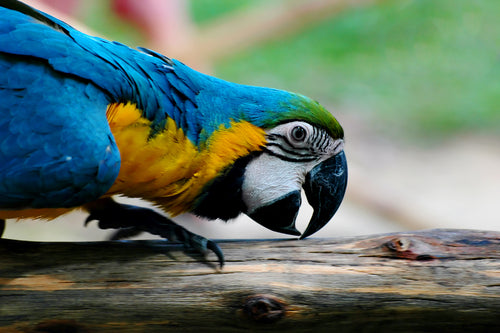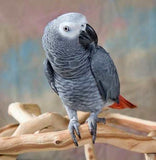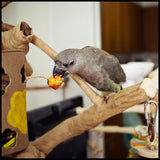Table of Contents
by: Phil Samuelson

When it comes to buying the best parrot perch for your cherished feathered friend, look at the perch possibilities like you would a good pair of running shoes.
When you sit down to try on a pair of athletic shoes at a shoe store, you know pretty quickly when the shoes are either too tight or too loose. Neither of these improper fits is desirable or comfortable.
No one likes tight shoes. The idea of wearing them for long periods is unthinkable. Loose shoes feel slightly better, but if there is much movement and toe wiggle, you just know you're asking for trouble if using them on a long run. Blisters and raw, sensitive areas are sure to result.
In contrast, when you sit down and try on a pair of properly fitting shoes, you know pretty quickly when the fit is perfect. Your feet feel snug but comfortable. A walk around the room allows for little "play" inside the shoes, with minimal rubbing of your feet against the shoe interior.
What's That Got To Do With My Parrot Perch?
The same goes for choosing a bird perch. Fit is everything. In the avian world, not only pet parrots appreciate a proper perch fit. Shop for your birds' perches with the same scrutiny you would with running shoes. Perches must keep your bird's feet comfortable and exercised.
What Perches Are Best For Birds?
Incorrect perch lengths and diameters are the two most common mistakes bird owners make when buying perches. The most common mistake is buying a parrot perch with a diameter that is too small, with the owner thinking her pet will appreciate a perch that is easy to grasp.
However, perches with small diameters are actually uncomfortable for the bird since there isn't enough room to achieve a secure grip. The bird's feet should encircle approximately 3/4 of the perch, with nail tips firmly touching the surface.
Perch length is just as important.
An appropriate perch must be at least as long as the full wingspan of the bird. This way, the bird will be able to comfortably flap its wings without striking the cage bars and risking injury.
Think of how uncomfortable you would be if you could never stand fully upright. Cramping a bird so it cannot extend its wings is a similar situation.
What can I use for a bird perch?
Wood is probably the best choice for perch material since it is smooth and allows the bird a replaceable surface to chew—and almost every pet parrot loves to chew!
Other acceptable perch materials include rope, pumice or cement (which is a great material for keeping sharp bird nails dull). There are even heated perches to keep avian feet warm and bathing perches that attach to shower walls with durable suction cups.
Whatever type of bird perch you choose, be sure that appropriate size and comfort are your primary considerations when making a selection.

Natural Branch Parrot Perches are one of the most popular perches because they are easy to clean and good for parrots. Natural branches from real hardwood trees or shrubs offer variable diameters across the length.
Some wood bird perches, like the Java Perch, have unique twists and turns, too. Variable diameters are highly important to help your parrot maintain optimum foot health.
What to know about parrot feet when choosing a bird perch
To understand, you may need to learn a little about the parrot foot. Looking at the parrots’ feet below, you’ll see that they are zygodactyl, meaning that two toes point forward and two toes point backwards.
Designed for superior climbing abilities and even for holding food each toe on a birds’ foot has a different amount of joints in it and numerous muscles.
You know just how strong a parrots toes are if you’ve ever tried to trim your parrots’ toenails!

Look at the close up of this parrot foot. It is Peachy’s foot, a Moluccan Cockatoo. Peachy, like all parrots, must stand, climb and eat with his feet all day and all night long.
It only makes sense that parrots need perches that offer significant variation in diameter. Just imagine how cramped a parrots foot could get if it were only able to grip a single diameter, like a dowel wood perch.
You probably know for yourself how stiff your feet can get when you stand on them for a few hours. And, when your feet hurt, it seems that you hurt all over.
Encourage your parrot to exercise the joints and muscles in its well-used feet with a Natural branch bird perch that features twists and variable diameters across the length of the branch.
Compare Natural Branch Parrot Perches
| Manzanita Perches | Dragonwood Perch | Java Wood Perches | |
 |
 |
 |
|
| Density | Grown in American Northwest; 8th most dense wood; used for wood perches and wood bird stands. | Very hard wood harvested in American Southeast; Tough inner core with unique, enticing bark that is easy to grasp and fun to chew. | Imported from coffee growing countries, extremely hard Java wood is one of the only plants to grow in a twisted, horizontal pattern. |
| Bark | Slick, peeling bark, picture shown is hand-scraped. Has enough variation in diameter that birds with healthy feet and toes intact have no difficulties gripping appropriately sized wood perches. | Textured bark for fun chewing. Excellent wood perch for birds that have arthritic or compromised feet including missing toes or toe nails. | Hand Scrapped production increases perch diameter variability. This allows birds with healthy feet to firmly grip the perch. |
| Variability | Very good gripping, especially with trimmed off shoots. | Moderate Variability | Highly variable within each branch |
Based on cholla wood or a dried cactus surface, edible bird perches provide a soft wood framework that is filled with healthy minerals. Cholla wood features a unique surface that is a soft wood, easy to grip and engages your parrot to chew. Chewing minerals provides for a healthy bird while conditioning the beak.
Polly's Pet Products, a veterinarian owned and inspired company has created some research based, nutritious mineral formulas that they inject into cholla wood. The mineral inside cholla wood inspires your bird to chew and explore gaining important nutrients while it forages.
Pass this article along to your friends who are in the market for a parrot perch.
Diane Burroughs, LCSW is a licensed psychotherapist trained in ABA therapy techniques. She specializes in anxiety disorders and nutrition for mental health. With over 30 years experience, in a range of settings, she’s created thousands of successful behavior plans to help turn around challenging behavior. She’s authored a number of books on supporting challenging behavior in birds.
Hey there! Because of conscientious parrot caretakers like you we are able to continue to offer valuable, science-backed parrot wellness support that will help your feathered friend to thrive so that you can enjoy it for years to come.
Please take a moment to share this blog with your friends and on your social media. If you want to learn more about science back parrot Wellness, check out my social media channels like YouTube and Pinterest. And request access to my private Facebook group, UnRuffledRx Feather Plucking Help. I can find it by clicking the banner below.


